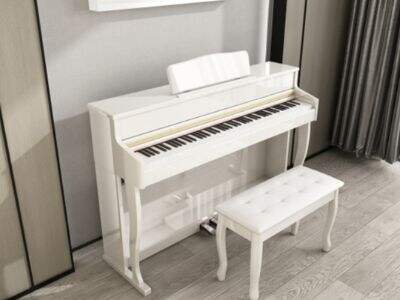The piano is one of the most popular instruments in the world. It is recognizable to many, and it occupies a special space in music. If you want to learn to play the piano, it will really help you out to know the various types you can choose from. In this beginners guide, we’ll take a look at three different types of pianos and keyboards; digital pianos; acoustic pianos and electronic keyboards. They come with their own characteristics and tones, and understanding them can help you select the one that suits your musical journey the best.
Digital Piano Versus Acoustic Piano Versus Electronic Keyboard
Let’s start with the digital piano. Digital pianos are instruments that replicate an acoustic piano sound using technology. Acoustic piano is a classical instrument that produces sound through the interaction of hammers with strings and makes beautiful music. Digital pianos are typically more compact and lightweight, which means they are far easier to transport. Mistake: They often include built-in speakers, which means you can play music without needing other equipment. Most digital pianos provide a headphone output if you want to practice quietly too. And they can also stream to other devices for more music options.
Now, let’s get to know the acoustic piano. The funguo za piano 88 za kibodi traditional type of piano that most people are familiar with is the acoustic piano. You press the keys and it creates music by striking strings with hammers. There are two categories of acoustic pianos: upright pianos and grand pianos. Upright pianos are smaller, so they are a better option for those with little space in their homes. They also tend to be less expensive. In contrast, grand pianos are more impressive and bigger, however they also cost considerably more. Acoustic pianos require regular tuning and maintenance to sound their best, so you’ll want to consider that if you go this route.
Coming up next is the electronic keyboard, also known as a synthesizer. Electronic keyboards, for example, can generate several sounds replicating those of various instruments, such as pianos. There are all sizes and styles, and most have some great features like rhythms and effects to make your music a little bit more fun. While they can generate sounds similar to a piano, though, they may not quite sound as authentic as those from a more conventional instrument (such as a digital or acoustic piano). This is something to keep in mind when you are making up your mind on which instrument to play.
There are many factors to take into consideration when choosing a piano or keyboard.
First of all, it is crucial how experienced you are in music. Digital piano or electronic keyboard might be a better choice for beginners. These instruments are generally cheaper than acoustic pianos, and they are easier to play. You can start your music journey without spending too much money. However, high-quality sound comes with acoustic piano so, if you are an experienced pianist and you prefer rich sound acoustic piano is the right choice for you. Another important thing to keep in mind is the space where you are going to place your instrument. Some acoustic pianos are big and heavy to move. If your living space is limited, digital piano or electronic keyboard is a better choice for you. It is compact and portable, and it is much easier to move it from one place to another. If kibodi ya piano funguo 88 zilizopimwa you need to have a piano away from your current location, a digital piano or electronic keyboard is the best option. What sounds better? It is difficult to say which piano sounds better.
Another aspect to consider is the quality of the instrument itself. A good digital piano or electronic keyboard sometimes does a better job sounding better than a cheap acoustic piano. So, when you are picking the right instrument for you, factor in your experience level, your budget, and what sounds resonate with you the most.
The Pros and Cons of Each Type of Piano or Keyboard
Each type of piano has its pros and cons. Here are some key pros and cons to consider:
Digital Piano:
Faida:
Less expensive than an acoustic piano, which helps a beginner.
No tuning required — save time and money.
Smaller, easier to relocate and great for smaller areas.
Usually includes features such as metronomes to assist with practice, as well as the ability to record the music you produce.
Africa:
Some players may not hear it as realistic as an acoustic piano.
The kibodi yenye funguo zenye uzani 88 keys may feel different and may not be as responsive as an acoustic piano.
Acoustic Piano:
Faida:
Delivers a rich and genuine sound, which many musicians like.
A physical feel of an acoustic piano also work in building finger muscle strength.
No new technology can duplicate the sound quality of magic acoustic pianos that continues to impress, while new mechanical pianos, digital pianos, or electronic keyboards cannot.
Africa:
Can be quite pricey, and that can be an issue for some families.
Requires some maintenance and tuning that tend to take some time and use up some funds.
Because it's heavy and difficult to transport if you need to move locations.
Kibodi ya Kielektroniki:
Faida:
Great beat processor and gets you all creative types of sounds and features.
Generally costs less than a digital or acoustic piano, which is ideal for beginners.
Their wide range of sounds means you can produce all kinds of music effortlessly.
Africa:
Less realistic: Not as realistic-feeling as a digital or acoustic piano.
The key action may feel different and less responsive than that of an acoustic piano.
How Digital Pianos and Keyboards Operate
If you are switching from acoustic pianos, digital pianos and electronic keyboards function differently. Rather than use strings and hammers to create sounds, they use technology. With a digital piano, pressing down on a key activates sensors beneath the keys that send signals to a sound module. Next, this module simulates the sound of an acoustic piano with recordings.
Electronic keyboards use a different method to produce sound. They use sound synthesizers, which adjust sound waves electronically, to create numerous distinct sounds, including piano sounds. Most musicians find features such as rhythm accompaniments and effects that are built right into electronic keyboards to make their music all the more enjoyable.
Acoustic pianos — these are the classic ones — produce sound the old-fashioned way. They use hammers and strings. When you strike a key, a hammer strikes a string, making a resonant sound that is amplified by the instrument’s soundboard. That’s what creates the beautiful sound we think of when we hear the piano.
Final Bolan Shi offers a good selection of pianos and keyboard, each with great advantages and disadvantages. Can You Find the Right Bolan Shi for You? Whether you are just starting to leap into the world of music or you have been moving your fingers up and down for a long time, a Bolan Shi piano or keyboard can suit you. The difference in terms of digital pianos vs acoustic pianos vs electronic keyboards can be confusing, so this will help you make a smarter decision and find an instrument that is the best fit for you and allows you to enjoy playing music!

 EN
EN
 AR
AR
 DA
DA
 NL
NL
 FR
FR
 DE
DE
 EL
EL
 HI
HI
 IT
IT
 JA
JA
 KO
KO
 HAPANA
HAPANA
 PL
PL
 PT
PT
 RU
RU
 ES
ES
 SV
SV
 TL
TL
 ID
ID
 SR
SR
 VI
VI
 ET
ET
 HU
HU
 MT
MT
 TH
TH
 TR
TR
 FA
FA
 MS
MS
 SW
SW
 BE
BE
 AZ
AZ
 KA
KA
 BN
BN
 HA
HA
 JW
JW
 MR
MR
 PA
PA
 TA
TA
 TE
TE
 KK
KK
 UZ
UZ




